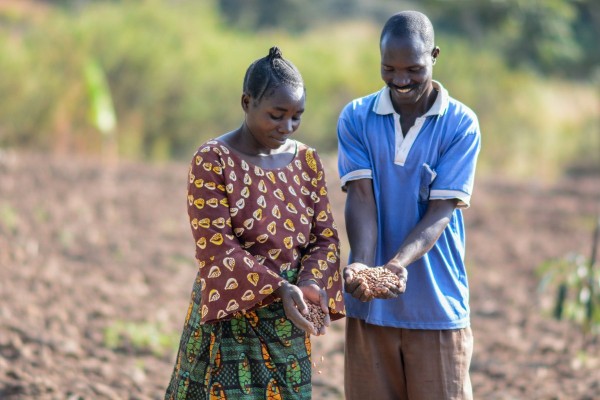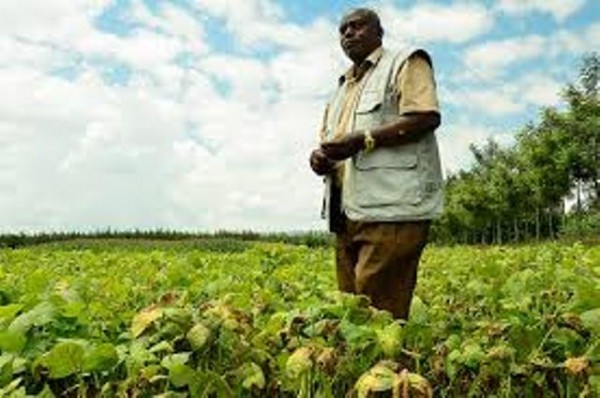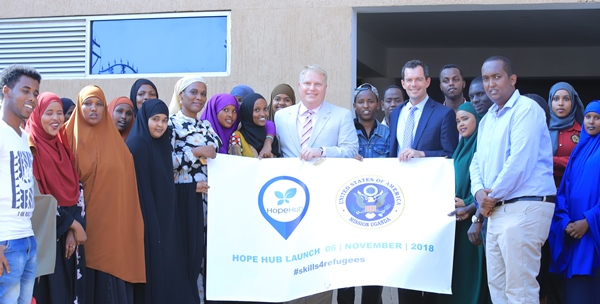Kampala, Uganda, 02nd Sept, 2016– NARO researchers at NaCRRI in collaboration with Harvest plus, CIAT, USAID Feed the Future have developed and tested new bean (Phaseolus vulgaris L.) varieties that have higher levels of both iron and zinc.
The new bean varieties have recently been released for official production and use to the Ugandan farmers.
According to Dr Stanley Nkalubo, Head of Legumes research at NaCRRI, the use of bio fortified foods is a very cheap method of overcoming or preventing some of these malnutrition issues especially for resource poor families.
“The bio fortified beans that are breed to have high levels of iron and zinc can be grown easily like any other common beans that farmers are growing. The only difference with these beans is that they have relatively higher levels of iron and zinc and this translates into higher levels of these nutrients being taken up by whoever consumes them,” Dr Stanley Nkalubo, Head of Legumes research at NaCRRI relaying why he advocates for the purchase and consumption of the new varieties over the ordinary ones.
He adds that the new varieties have an edge over the old ones in terms of higher levels of iron and zinc properties.
“The new varieties have an increase in iron from 20-25 percent over the ordinary ones, early maturity and can require less rainfall thus can be grown in earlier with little or low rainfall. These varieties mature in 60-75 days for the bush varieties (NAROBEAN 1, NAROBEAN 2 and NAROBEAN 3) and 85-95 days to maturity for the climbers (NAROBEAN 4C and NAROB” said Dr Nkalubo.
Distinguishing factors between the new varieties and old ones vary with each bean type.
According to Dr Nkalubo, each new variety has unique distinguishing features and they have been given names to differentiate them.
“Five varieties given serial names including NAROBEAN 1 (Kidney shaped bean greyish with black stripes), NAROBEAN 2 (oval shaped bean with red and while speckles), NAROBEAN 3 (medium sided oval shaped bean yellow in colour), NAROBEAN 4C (white and red speckled roundish bean) and NAROBEAN 5C (Yellow Kidney bean) with letter C meaning that this particular variety is a climber and requires stakes (sticks) for support while being grown in the garden. The first three varieties, 1, 2 and 3 are bush beans which do not need support while being grown in the garden,” observed Dr Nkalubo.
Why Farmers should be interested in the new varieties
Dr Nkalubo advises that farmers should be interested in these varieties because they provide higher nutritional value that would lead to increased blood formation. And that the varieties are therefore very important for the all women especially those of child bearing age and the young children.
Agronomic practices for both varieties are the same
Dr Nkalubo said that ‘’The agronomic practices are still the same for the new and old varieties, adding that spacing should be at 50 cm between rows and 10 cm within row for the bush beans (NAROBEAN 1, NAROBEAN 2 and NAROBEAN 3) and 50 cm between row and 20 cm within row for the climbers (NAROBEAN 4C and NAROBEAN 5C).”
He however adds that it is recommendable for farmers to employ the use of artificial or organic fertilizers in areas where the soils are poor or not fertile.

Prices for the old and new varieties
Dr Nkalubo clarified that there would be no changes in the price for the new variety, explaining that the cost will remain as the same level with the old varieties.
According to the Uganda Demographic and Health report 2006, nearly 38% of Ugandan children below 5 years are stunted, 6% are wasted and 16% are underweight, which puts Uganda among the few countries with the highest malnutrition rates. These persistent high rates of malnutrition in these children are symptomatic of the larger problems of inadequate access to food and suboptimal infant feeding practices leading to poor health. Malnutrition plays a major role in child morbidity and mortality.
Micronutrient deficiencies like iron and zinc are a major component of this child malnutrition and various health complications in especially expectant mothers and other adults.
Iron deficiency carries significant adverse consequences for child development both in the short and long term.
An analysis into the Ugandan nutrition situation conducted by the Ministry of Health in 2010 revealed that Iron-deficiency anemia (IDA) affects 73 percent of preschool children and 49 percent of women of childbearing age. In adults the lack of enough iron in the body leads to low hemoglobin levels in your blood a condition referred to anemia and causes one to normally feel tired, have poor concentration and have an increased risk of infection.
On the other hand, zinc deficiency may lead to delayed growth and development in children and adolescents, hair loss, diarrhoea, delayed wound healing, loss of appetite and weight loss and can also lead to under development of male sexual organs.
“Therefore the growing of bio fortified food crops would be the most preferred sustainable and affordable option for such households,” suggested, Dr Nkalubo.
Studies that have been conducted by food and nutrition scientist to evaluate iron and zinc retention in raw beans after cooking either by regular pot cooking or pressure cooking, with and without previous water soaking, and broth, established that regardless of the cooking method, with or without previous water soaking, the highest zinc concentration was found in the cooked bean grains.
However, pressure cooking and previous water soaking diminished iron retention in the cooked grains, while increasing it in the bean broth. This study thus confirmed that the common bean was an excellent source of iron and zinc for human consumption, and it was suggested that beans should be consumed in a combined form, i.e. grain with bean broth.
This study thus suggests that the utilisation of the bio fortified beans varieties like those that have been developed by NARO is very beneficial in solving malnutrition cases like those faced by children and mothers in the Uganda resources poor farm families.
Maize varieties
A detailed insight about the four new drought tolerant maize hybrids that the National Variety Release Committee(NARO) approved for release on July ,22, 2016 details that the The maize varieties; WE 1101, WE 31013, WE 3106 & WE 3109 are improved conventional white maize hybrids with desirable qualities including; drought tolerance, high yield and disease resistance. And that they were developed through the Water Efficient Maize for Africa (WEMA) public-private partnership.
According to Ms Winnie Nanteza, Public relations officer at NARO, Namulonge; The maize is being marketed by seed companies using the brand name Drought TEGO as a trade mark.
“Some of these products have been multiplied and are now available in the market with seed companies. NARO is proud to be associated with development partners and collaborators including Project activities funded by the Bill & Melinda Gates Foundation, Howard G. Buffet Foundation and the United States Agency for International Development (USAID), African Agricultural Technology Foundation (AATF), and International Centre for Maize and Wheat Research (CMMYT). These hybrid varieties commercially marketed under the brand name; Drought TEGO are developed to help smallholder farmers in Sub-Saharan Africa address growing climate change challenges. The maize is bred with important traits that meet the needs of Uganda’s farmers with ability to give higher yields within dry environments. They also have resistance to rampant leaf diseases like maize streak virus, turcicum leaf spot and gray leaf spot.
The strengths of the new varieties over the old ones and areas best suited for planting the new varieties.
Ms Winnie Nanteza, Public relations officer at NARO, Namulonge, said the WEMA varieties were tolerant to conditions of drought and could give a yield advantage of 20-30% over other commercial varieties. She added that, the varieties also gave up to 27-35 bags of 100kgs per acre on average under optimal smallholder farmer conditions.
Ms Nanteza noted that it takes the seeds an average of 120 days (3-4months) to mature, depending on the agro-ecological zone. “They are suited for low to medium altitude areas (all the maize growing regions of Uganda except the highland areas).”
“The new maize varieties which have white and hard grain are suitable for milling. They also have good husk covers on the cob that protects the grains from damage by birds, grain rotting by preventing water from entering into the cobs and are resistant to major leaf diseases including Northern leaf blight, Grey leaf spot, Maize streak virus.” She observed.
Ms Nanteza urged farmers to acquire the new varieties because they have been bred with important trials that withstand the increasing effects of climate change especially drought and increased disease pressure, saying “The WEMA seeds varieties are expected to give farmers an average yield of three tons per hectare in moderate drought and eight tonnes in good seasons and thus help farmers fight hunger through increased productivity.
Ms Nanteza, in a press statement said that she was hopeful; the new varieties would lead to increased maize production, improve food security, wealth creation and therefore improve farmer livelihoods.
Agronomic practices associated with the new varieties.
Crop management
Deputy director general ,NARO ,Dr Yona Baguma spelled out the dos and don’ts of crop management in a flier encouraging farmers to monitor their fields regularly for stemborer damage and eggs under side of the crop leaves, control stemborer with recommended pesticides at 3-5leaf stage, 3-4weeks after planting or when 5-10% plants are affected.

He cited that land preparation was an essential phase before and during planting. He urged farmers to plough back crop residues to improve soil fertility and texture, saying “prepare your land early to ensure a good soil tilth that supports germination and seedling emergence also practice weeding.”
Dr Baguma’s advice to farmers during planting as per flier
Farmers are recommended to plant 10kg/acre or 25 ha of certified seed (1ha205acres), space the seeds (75cm-25cm in medium altitude and 90cm 30cm in low drylands and sow 2 seeds per 5cm deep hole. Apply planting basal fertilizer or organic manure at recommended rate before and during planting.
They are urged to apply the (basal) fertilizer below the seed and cover the fertilizer with soil before planting the seed to avoid direct contact with the fertilizer and to thereafter, repeat the stemborer control application if signs appear at the 10 leaf stage.
Maize leaf Nercrosis disease (MLND) management
Drought TEGOTM seeds are treated with systematic insecticide that helps to manage vectors of maize lethal Necrosis (MLN) and other diseases and pests during early growth stages of maize, to prevent further MLN virus transmission .farmers are recommended to pullout and destroy MLN infested plants and to wear personal protection equipment when handling or applying plant protection products.
Prices for the seeds and produce.
Ms Nanteza, said that NARO did not sell seeds to farmers but engaged companies like NASECO who determine their own prices which usually ranges between shs 4000 and shs 6000.
When our reporter asked Mr Amin Kalyowa an extension worker at Nalweyo Seed Company (Naseco) about the cost per kilogram of seeds, he told us that the price was vague since they were currently distributing the new maize seeds free of charge.
Mr Kalyowa, who has been an extension worker at Naseco for the past two years in areas of Mubende and Mityana , said that farmers in these sub counties specifically: Kiluni and Madudu both located in Mubende district, Kalangalo and Manyi in Mityana have been given the new maize varieties,(WEMA) free of charge.
“Our priority is currently directed to the maize seeds. We have done demonstrations, sensitized farmers about benefits the new varieties have over the ordinary ones and agronomic practices performed before and during planting” noted Mr Kalyowa.
Augustine Kintu, a farmer from Kalangalo sub county-Mityana observed that the new maize varieties were drought resistant and could easily grow in infertile areas. “I planted my WEMA seeds on April, 7, 2016 and am looking forward to harvesting them in the nigh three months. The seeds produce one big cob bearing a lot of seeds; on removal of the seeds the cob becomes small.”
He identified that the prominent difference between the WEMA seeds and the ordinary varieties was the application of DAP (Di Ammonium Phosphate) in the soil and NPK (Nitrogen Phosphorus Potassium) within the rows in the garden before planting the seeds adding that agronomic practices for both new and ordinary varieties remain constant.
***Ends***
We want your news! Do you have a story? Have you witnessed an important news event? We are always interested to receive Uganda-related news of interest to our visitors.
Send us your photos or videos and share your story at brian@guide2uganda.ug
Click the links below to check; Hotels in Uganda, Useful contact number in Uganda, Flights to Uganda, Uganda News, Uganda Events, Real estate in Uganda, Sleep in Uganda, Where to Eat in Uganda, Uganda Businesses, Classifieds and Work in Uganda plus Uganda holidays & Attractions.




